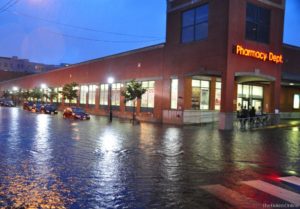
FIST PUMP: Despite Roaring Nor’easter, Hoboken Flooding at a Minimum
That noise you heard this morning was a collective gulp coming from the citizens of Hoboken, many of whom watched the Hudson River taunt its threshold throughout last night’s heavy nor’easter.
As the rains lashed and the winds howled on the waterfront, the river reached minor flood stage at this morning’s 6:06 a.m. high tide. However, in a town infamous for its chronic flooding woes, there are no reports of any damage from the storm.

Area submerged after 2011 storm (image via TheBoken)

Same area, last night (image via City of Hoboken)
Most notably, the back of Hoboken—where cars, homes and businesses have routinely been washed out be even a passing steady rain—stayed above water, thanks in no small part to the newly installed pumps servicing that area.
“For the third time yesterday, our new H-5 flood pump, combined with our existing H-1 pump, kept western Hoboken dry through the kind of major storm that previously would have flooded our neighborhoods,” says Hoboken Mayor Dawn Zimmer. “Thank you to the Office of Emergency Management, Police and Fire Departments, Environmental Services, and Construction Office for making sure we were prepared for yesterday’s storm.”
A perennial political football here in town, the pumps were finally given the go-ahead in early 2015, coming online at the end of last summer. The two pumps combine to give the city and partner North Hudson Sewerage Authority (NHSA) the capacity to pump 80 million gallons of water a day out of the western parts of Hoboken—a lifesaver for residents and business owners who have lived under a constant threat of deluge for years and years.
Nevertheless, the flood threat for Hoboken will constantly be at hand. According to the Stevens Flood Advisory System, this morning’s minor flooding was brought on by a river rise of 4.8 feet. Had there been a mere two feet more of storm surge, the river would have once again breached its barriers and flowed into the western part of town.

Tracks at Hoboken Terminal submerged under flood waters last night.
As it was, the train tracks in NJ Transit’s Hoboken Terminal were submerged under water when the Hudson crept over its banks last night. Service continued as scheduled, and the PATH Terminal, which lies directly underneath the NJT Terminal, was not impacted… this time.

PATH flooding from a nor’easter in 1992 (City of Hoboken)
Following Superstorm Sandy, the PATH was hobbled for months, as the storm surge swamped the subterranean transit line system-wide—a common occurrence in days past.
To that end, the City has made a vow to continue its fight against the river and other flooding threats.
“As we saw the river splash over the bulkhead along Weehawken Cove and fill the tracks in Hoboken Terminal, yesterday was also a reminder that we face a real flood risk not just from downpours, but from the river itself – and not only during hurricane season,” says Mayor Zimmer. “That is why the Rebuild by Design project is so important, and I invite everyone to attend the public hearing on the Draft Environmental Impact Statement for the project on March 16.”
CLICK HERE for more information on Rebuild by Design.

The wet weather pump stations were installed in the summer of 2016.

 Previous Article
Previous Article Next Article
Next Article LIVE MUSIC: The Royal Arctic Institute and Jim Scheiner — TONIGHT @ Issyra Gallery, Neumann Leathers Building
LIVE MUSIC: The Royal Arctic Institute and Jim Scheiner — TONIGHT @ Issyra Gallery, Neumann Leathers Building  Work it Out Wednesday: Running in Hoboken
Work it Out Wednesday: Running in Hoboken  FEATURED PROPERTY: 207 Manhattan Ave — Panoramic NYC Views; 3-4BR Units Available
FEATURED PROPERTY: 207 Manhattan Ave — Panoramic NYC Views; 3-4BR Units Available  GET YOUR FRINK ON: New App Promises Free Booze???
GET YOUR FRINK ON: New App Promises Free Booze???  Family of Hoboken Train Crash Victim Files Lawsuit
Family of Hoboken Train Crash Victim Files Lawsuit  WE’LL DRINK TO THAT: Hoboken City Council Amends ‘500-Foot Rule,’ Allowing Flexibility in Bar/Restaurant Growth
WE’LL DRINK TO THAT: Hoboken City Council Amends ‘500-Foot Rule,’ Allowing Flexibility in Bar/Restaurant Growth  PROST: Saints Peter & Paul Hoboken Oktoberfest 2018— FRI, SEP 21 & SAT, SEP 22
PROST: Saints Peter & Paul Hoboken Oktoberfest 2018— FRI, SEP 21 & SAT, SEP 22  Hoboken Catholic Academy 5K — June 6th; Early Registration Deadline THURSDAY
Hoboken Catholic Academy 5K — June 6th; Early Registration Deadline THURSDAY